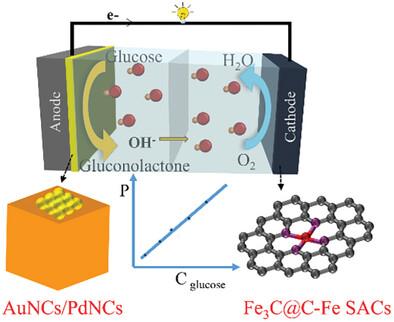Self-Powered Glucose Biosensor Based on Non-Enzymatic Biofuel Cells by Au Nanocluster/Pd Nanocube Heterostructure and Fe3C@C-Fe Single-Atom Catalyst
IF 13
2区 材料科学
Q1 CHEMISTRY, MULTIDISCIPLINARY
引用次数: 0
Abstract
Self-powered biosensors (SPBs) based on biofuel cells (BFCs) use electrical output as a sensing signal without the need of external power supplies, providing a feasible approach to constructing miniaturized implantable or portable devices. In this work, a novel nanozyme of gold nanoclusters/palladium nanocubes (AuNCs/PdNCs) heterostructure is successfully fabricated to develop an innovatively self-powered and non-enzymatic glucose sensing system. The AuNCs/PdNCs with glucose oxidase (GOD)-like activity exhibits superior electrocatalytic and non-enzymatic sensing performance toward glucose. The non-enzymatic BFCs-based SPBs system, established on the AuNCs/PdNCs (anodic catalyst) and single atomic Fe sites coupled with carbon-encapsulated Fe3C crystals (Fe3C@C-Fe SACs as a cathodic catalyst) platform, exhibits an exceptional sensitivity to glucose with 0.151 µW cm−2 mm−1 (3.4 times higher than the PdNCs), outstanding selectivity and robust stability. The outstanding performance of the BFCs-based SPBs system can be attributed to the synergistic cooperation between the PdNCs and AuNCs.

求助全文
约1分钟内获得全文
求助全文
来源期刊

Small
工程技术-材料科学:综合
CiteScore
17.70
自引率
3.80%
发文量
1830
审稿时长
2.1 months
期刊介绍:
Small serves as an exceptional platform for both experimental and theoretical studies in fundamental and applied interdisciplinary research at the nano- and microscale. The journal offers a compelling mix of peer-reviewed Research Articles, Reviews, Perspectives, and Comments.
With a remarkable 2022 Journal Impact Factor of 13.3 (Journal Citation Reports from Clarivate Analytics, 2023), Small remains among the top multidisciplinary journals, covering a wide range of topics at the interface of materials science, chemistry, physics, engineering, medicine, and biology.
Small's readership includes biochemists, biologists, biomedical scientists, chemists, engineers, information technologists, materials scientists, physicists, and theoreticians alike.
 求助内容:
求助内容: 应助结果提醒方式:
应助结果提醒方式:


